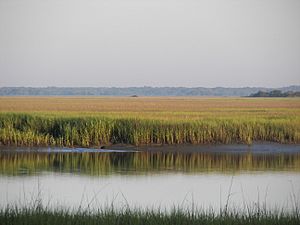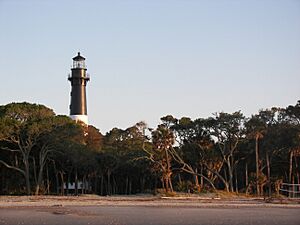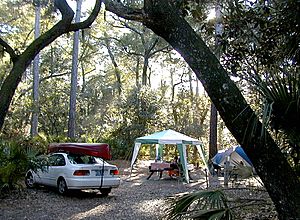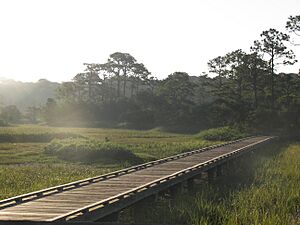Hunting Island State Park facts for kids
Quick facts for kids Hunting Island State Park |
|
|---|---|
| Hunting Island | |

Marshes surrounding Hunting Island
|
|
| Type | State park |
| Location | Beaufort County, South Carolina (Lowcountry & Sea Islands) |
| Nearest city | Beaufort |
| Area | 5,000 acres (20.2 km2) |
| Elevation | Sea level |
| Created | 1935 |
| Etymology | "Hunting Islands" map reference (c. 18th century) |
| Operated by | South Carolina Department of Parks, Recreation & Tourism |
| Visitors | 1.2 million |
| Camp sites | Both regular and RV campsites |
| Hiking trails |
|
| Other information | Admission fees: $8.00 for adults $5.00 for S.C. seniors $4.00 for children ages 6-15 free for children ages 0-5 |
Hunting Island is a large, quiet island in South Carolina. It covers about 5,000 acres (20.2 km2) and is a barrier island. You can find it about 15 miles (24 km) east of Beaufort. It sits between Harbor Island and Fripp Island.
Since 1935, Hunting Island has been a state park. It is the most popular state park in South Carolina. It is also part of the ACE Basin estuarine reserve area. This means it's a special place where rivers meet the sea. The island is famous for its natural beauty. It is one of the last undeveloped Sea Islands in the Lowcountry region. A famous 19th-century lighthouse stands on the island. Its beach has been called one of the top 25 beaches in the U.S. by TripAdvisor.

Contents
Hunting Island's Past
Hunting Island got its name from long ago. In the 1800s, rich landowners used these islands for hunting. That's why they were called the "Hunting Islands."
The Lighthouse's Story
The first lighthouse on Hunting Island was built in the 1850s. But it was destroyed by Confederate forces early in the American Civil War. Ten years after the war, the lighthouse was rebuilt. Later, it was moved to where it stands today. The lighthouse survived the powerful 1893 Sea Islands hurricane. This storm swept over Hunting Island and other nearby islands.
Becoming a State Park
In the 1930s, Hunting Island became a state park. The Civilian Conservation Corps helped build it. They also built bridges to connect the outer Sea Islands to Beaufort. Because there hasn't been much building, the island is a safe place for wildlife. It has over 4 miles (6.4 km) of beach. There's also a thick maritime forest and a large saltwater marsh. The old lighthouse is a main attraction. It's listed on the National Register of Historic Places. Even though it doesn't guide ships anymore, its light still spins at night.
Roads and Erosion
Since 1953, U.S. Route 21 has ended on Hunting Island. Part of the highway was lost to erosion around 1980. Erosion means the land slowly wears away. This made the state create a new park entrance. It also led to one-lane roads through the palmetto forest.
Since 1980, the beach has faced a lot of erosion. This is because of strong tides from the Atlantic Ocean and Saint Helena Sound. Experts think the island might shrink by ten percent in the next 40 years. Sometimes, you can even surf here. The best time is about three hours before high tide.
Filming Location
Hunting Island has been a movie set! Many of the Vietnam scenes in the movie Forrest Gump were filmed here in 1993. Parts of the 1997 movie G.I. Jane were also filmed in the island's forests.
Island Wildlife
Hunting Island is home to many animals. You can find loggerhead turtles, deer, alligators, and raccoons. There are also diamondback rattlesnakes. Hundreds of bird species live here too. These include herons and egrets. In summer, you might even see a painted bunting.
Loggerhead Sea Turtles
Every summer, baby loggerhead turtles hatch from eggs buried in the sand. They then make their way to the ocean. Between 60 and 130 nests are laid on the beach each year. A group of volunteers called "Friends of Hunting Island" helps protect these nests. They walk the beach every morning during nesting season. They find and protect the nests to help the baby turtles.
Other Wildlife
The island has a lagoon that was made in 1968. It has become a natural home for sea creatures. You might find seahorses and even barracuda there.
Park Facilities
Hunting Island offers places for recreational vehicles and tent campers. These spots are on the northern part of the island. Most of the park's cabins have been lost to beach erosion. A 2-mile-long (3.2 km) lagoon is a good spot for fishing.
Visitor and Nature Centers
The Hunting Island Visitors Center is in the middle of the island. It looks out over a small lagoon. Here, you can get information about the island. It also has space for activities and park offices. The center connects to the island's many trails. It's also close to several beach access points.
The Hunting Island Nature Center has live animals. It also has exhibits about the park's habitats and history. This center is at the start of the Paradise Pier. This pier goes into the Fripp Inlet, between Hunting and Fripp Island.
Lighthouse and Beach Access
The lighthouse is open to visitors all year. You can climb to the top of the 136-foot-tall (41 m) tower. There is a small fee to do this.
Hunting Island has 4 miles (6.4 km) of beachfront. It offers a beautiful, natural experience for visitors. Even though the beach is eroding at the south end, there's still plenty of shore. You can find lots of beach in the middle and near the campground areas.
Trails and Boardwalks
The state park also has several trails for hiking and biking. One loop trail is 6.1-mile (9.8 km) long. It goes through the maritime forest and along the lagoon. This trail also connects to the Marsh Boardwalk. This boardwalk is a popular spot for photographers. A short walk across the marsh leads to a small island called a hammock. From there, you can reach a deck along a tidal creek.



